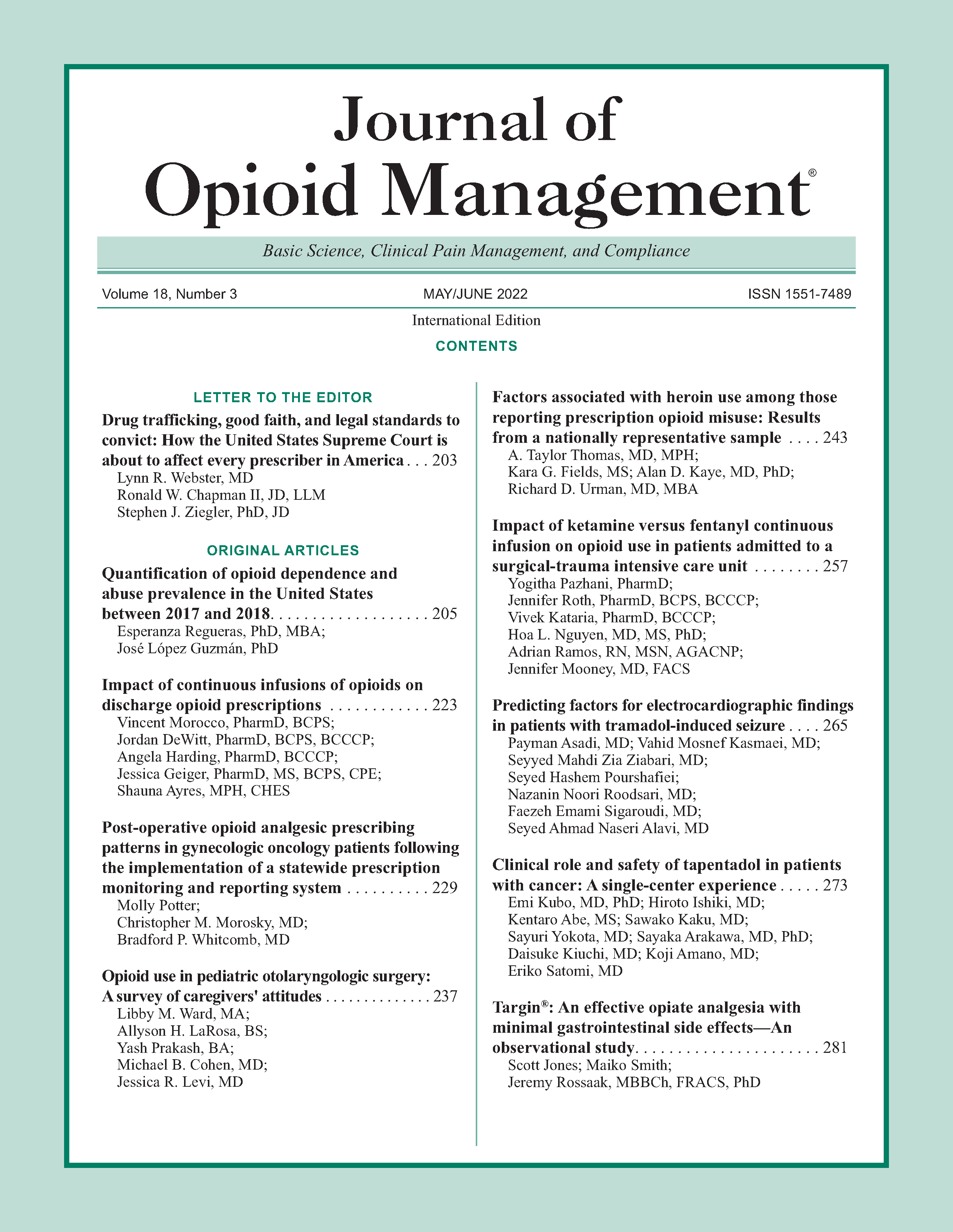Opioid use in pediatric otolaryngologic surgery: A survey of caregivers' attitudes
DOI:
https://doi.org/10.5055/jom.2022.0715Keywords:
opioids, parents, pain-management, pediatric surgery, otolaryngologic surgeryAbstract
Objective: Given the current opioid epidemic and the fact that children continue to be undertreated for pain following surgeries, it is important to understand caregivers’ attitudes toward post-operative opioid use.
Design: A survey was distributed to caregivers of pediatric patients undergoing otolaryngologic procedures.
Setting: An academic hospital in Boston, Massachusetts.
Participants: Sixty-eight caregivers completed the survey.
Main outcome measure: Caregiver attitudes toward post-operative opioid use.
Results: The study results are as follows: 38.1 percent of parents stated they would feel comfortable giving their child opioids post-operatively, 30.2 percent would not feel comfortable, and 31.7 percent were unsure. For every increase in 1 year of age of the child, there was an increase in the odds of a parent being comfortable giving opioids. Caregivers who had taken opioids in the past were more likely to feel comfortable, while those who were employed were less likely to feel comfortable. The most common reason reported for not feeling comfortable was addiction potential. The comfort level did not differ based on the caregivers’ education level, income, race, or language.
Conclusion: The majority of caregivers are unsure about or do not feel comfortable giving their child opioids post-operatively. Most are specifically concerned about the risk of addiction. Understanding caregivers’ views on opioids in a diverse patient population is essential, so surgeons can counsel caregivers and provide appropriate post-operative pain management in their patients.
References
Fortier MA, MacLaren JE, Martin SR, et al.: Pediatric pain after ambulatory surgery: Where's the medication? Pediatrics. 2009; 124(4): e588-e595. DOI: 10.1542/peds.2008-3529.
Twycross A, Finley GA: Children's and parents’ perceptions of postoperative pain management: A mixed methods study. J Clin Nurs. 2013; 22(21-22): 3095-3108. DOI: 10.1111/jocn.12152.
Rony RYZ, Fortier MA, Chorney JM, et al.: Parental post-operative pain management: Attitudes, assessment, and management. Pediatrics. 2010; 125(6): e1372-e1378. DOI: 10.1542/peds.2009-2632.
Power NM, Howard RF, Wade AM, et al.: Pain and behavior changes in children following surgery. Arch Dis Child. 2012; 97(10): 879-884. DOI: 10.1136/archdischild-2011-301378.
Lauder G, Emmott A: Confronting the challenges of effective pain management in children following tonsillectomy. Int J Pediatr Otorhinolaryngol. 2014; 78(11): 1813-1827. DOI: 10.1016/j.ijporl.2014.08.011.
Horton JD, Munawar S, Corrigan C, et al.: Inconsistent and excessive opioid prescribing after common pediatric surgical operations. J Pediatr Surg. 2019; 54(7): 1427-1431. DOI: 10.1016/j.jpedsurg.2018.07.002.
Razdan R, Stevens L, Ritchie M, et al.: Parents’ attitudes toward post-operative narcotic use in pediatric patients. Int J Pediatr Otorhinolaryngol. 2019; 124: 173-178. DOI: 10.1016/j.ijporl.2019.06.006.
Dorkham MC, Chalkiadis GA, von Ungern Sternberg BS, et al.: Effective postoperative pain management in children after ambulatory surgery, with a focus on tonsillectomy: Barriers and possible solutions. Paediatr Anaesth. 2014; 24(3): 239-248. DOI: 10.1111/pan.12327.
Longard J, Twycross A, Williams AM, et al.: Parents’ experiences of managing their child's postoperative pain at home: An exploratory qualitative study. J Clin Nurs. 2016; 25(17-18): 2619-2628. DOI: 10.1111/jocn.13307.
Scholl L, Seth P, Kariisa M, et al.: Drug and opioid-involved overdose deaths—United States, 2013–2017. MMWR Morb Mortal Wkly Rep. 2018; 67(5152): 1419-1427. DOI: 10.15585/mmwr.mm675152e1.
Harbaugh CM, Lee JS, Hu HM, et al.: Persistent opioid use among pediatric patients after surgery. Pediatrics. 2018; 141(1): e20172439. DOI: 10.1542/peds.2017-2439.
Voepel-Lewis T, Zikmund-Fisher BJ, Smith EL, et al.: Parents’ preferences strongly influence their decisions to withhold prescribed opioids when faced with analgesic trade-off dilemmas for children: A prospective observational study. Int J Nurs Stud. 2015; 52(8): 1343-1353. DOI: 10.1016/j.ijnurstu.2015.05.003.
Fortier MA, Martin SR, Kain DI, et al.: Parental attitudes regarding analgesic use for children: Differences in ethnicity and language. J Pediatr Surg. 2011; 46(11): 2140-2145. DOI: 10.1016/j.jpedsurg.2011.06.021.
Boston Medical Center: About us. 2016. Available at https://www.bmc.org/about-us. Accessed November 11, 2019.
National Institute on Drug Abuse: Massachusetts opioid summary. 2019. Available at https://www.drugabuse.gov/opioidsummaries-by-state/massachusetts-opioid-summary. Accessed November 11, 2019.
Barocas JA, White LF, Wang J, et al.: Estimated prevalence of opioid use disorder in Massachusetts, 2011–2015: A capture–recapture analysis. Am J Public Health. 2018; 108(12): 1675-1681. DOI: 10.2105/AJPH.2018.304673.
Published
How to Cite
Issue
Section
License
Copyright 2005-2025, Weston Medical Publishing, LLC and Journal of Opioid Management. All Rights Reserved.











